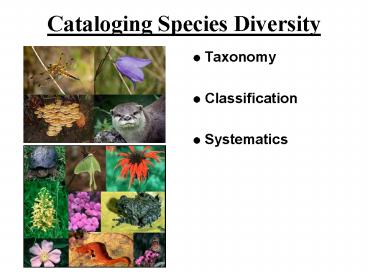Cataloging Species Diversity - PowerPoint PPT Presentation
1 / 9
Title:
Cataloging Species Diversity
Description:
Ailuropoda melanoleucas. Classifying Life. Hierarchical System of ... Genus Ailuropoda (2 species) Genus Helarctos (1 species) Genus Melurus (1 species) ... – PowerPoint PPT presentation
Number of Views:48
Avg rating:3.0/5.0
Title: Cataloging Species Diversity
1
Cataloging Species Diversity
- Taxonomy
- Classification
- Systematics
2
Taxonomy
robin
corn
bear
Taxonomy is the science of describing and naming
species
3
Binomial Nomenclature
- Binomial nomenclature naming system that uses
two names (Genus species) to represent each
unique species
Ursus arctos
Ursus maritimus
Ailuropoda melanoleucas
4
Classifying Life
- Hierarchical System of Classification
- Eight levels
- Domain
- Kingdom
- Phylum
- Class
- Order
- Family
- Genus
- Species
Do Kings Play Chess On Fine Grained Sand? Do Kids
Playing Chicken On Freeways Get Smashed?
5
Domain Eubacteria Domain Archaea Domain Eukarya
(5? Kingdoms) Kingdom Plantae Kingdom Metazoa
(many phyla) Phylum Arthropoda (insects,
spiders, crabs, shrimp, etc) Phylum Chordata
(ca. 10 classes) Class Chondrichthys
(sharks) Class Mammalia (26 orders) Order
Diprotodontia (koalas, kangaroos, etc) Order
Carnivora (ca. 15 families) Family
Procyonidae (raccoons, etc) Family Ursidae
Genus Ailuropoda (2 species) Genus
Helarctos (1 species) Genus Melurus (1
species) Genus Tremarctos (1
species Genus Ursus (5 species) Ursus
arctos
6
Phylogenetic Systematics
clade any group that descends from common
ancestor
Phylogenetic trees are hypotheses about the
evolutionary history of various taxa.
7
Monophyletic Group
Ancestral taxon and all of its descendant taxa.
Taxa B-H are monophyletic.
8
Paraphyletic Group
Ancestral taxon and some but not all of its
descendant taxa. Taxa A,I-K are paraphyletic with
respect to B-H.
9
Polyphyletic Group
Taxa in group do not share most recent common
ancestor. Taxa F-H,I-K are polyphyletic.































